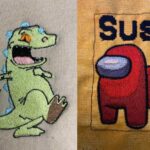Embroidery Bobbins Issues
A Beginner's Guide To Troubleshooting 10 Common Problems
Introduction
Machine embroidery is a beloved craft that allows creators to embellish fabrics with intricate designs and patterns. However, even the most seasoned embroiderers can encounter challenges with their machine embroidery bobbins. In this guide, we’ll explore the embroidery bobbin troubleshooting process and provide practical tips to resolve common issues.
Embroidery bobbins are the unsung heroes of machine embroidery, often overlooked but essential for achieving flawless stitching. As the source of the lower thread that combines with the upper thread to create intricate designs, understanding the basics of embroidery bobbins is paramount. From the types of bobbins used to the importance of proper winding and bobbin case maintenance, mastering these fundamentals lays the groundwork for successful embroidery projects.
So whether you’re a novice embroiderer or a seasoned pro, delving into the world of embroidery bobbin troubleshooting will equip you with the skills and knowledge needed to overcome common challenges and elevate your craft to new heights.
Embroidery Bobbin Troubleshooting: Understanding the Basics
Embroidery bobbins play a crucial role in machine embroidery, serving as the source of the lower thread that combines with the upper thread to create intricate designs. Understanding the basics of embroidery bobbins is essential for effective embroidery and ensuring smooth stitching. Here’s what you need to know:
Embroidery bobbins come in various materials, sizes, and styles, each with its own unique characteristics and applications. Plastic bobbins are lightweight and affordable, making them a popular choice for many embroiderers. On the other hand, metal bobbins offer durability and stability, ideal for high speed embroidery machines and heavy duty projects. Additionally, some bobbins feature prewound thread for added convenience, while others require manual winding.
Regardless of the type you choose, selecting bobbins recommended by the machine’s manufacturer ensures compatibility and optimal performance. Beyond the type of bobbin, understanding the importance of proper winding and tension adjustment is key to achieving consistent stitching results. By mastering these fundamental aspects of embroidery bobbins, you’ll be well equipped to troubleshoot common issues and unleash your creativity with confidence.
• Types of Bobbins: Embroidery machines typically use either plastic or metal bobbins. While both types can be effective, it’s essential to use bobbins recommended by the machine’s manufacturer to ensure compatibility and optimal performance reducing embroidery bobbin troubleshooting.
• Bobbin Size and Compatibility: Using the wrong size of bobbin can lead to tension issues and stitching problems, highlighting the importance of proper sizing is essential and a common bobbin troubleshooting step.
• Bobbin Winding: Properly winding the bobbin is essential for consistent tension and smooth stitching. Ensuring even winding is crucial in embroidery bobbin troubleshooting process to prevent issues such as thread breakage or tension irregularities. Ensure the bobbin is wound evenly and securely, following the machine manufacturer’s guidelines.
• Bobbin Case: The bobbin case holds the bobbin in place within the machine and is a critical component in embroidery. Ensuring the bobbin case is clean and properly seated helps prevent issues such as bobbin jams and uneven tension. When you have embroidered many items, it is a good practice to periodically employ this embroidery bobbin troubleshooting method.
Understanding these fundamental aspects of embroidery bobbins will help you troubleshoot common issues and achieve professional quality results in your machine embroidery projects.

1. Bobbin Thread Tension Issues
Uneven tension in the bobbin thread can lead to unsightly loops or puckering in the embroidery design, posing a significant challenge in machine embroidery. When the tension of the bobbin thread is too tight, it can cause the fabric to pucker or gather, distorting the design and compromising the overall quality of the embroidery. Conversely, if the tension is too loose, the stitches may appear loose or uneven, detracting from the precision and professionalism of the finished piece.
Embroidery machines feature tension adjustment mechanisms to control the tension of both the upper and bobbin threads, a crucial aspect of effective embroidery bobbin troubleshooting. To address bobbin thread tension issues, start by adjusting the tension settings on your embroidery machine. Begin with small adjustments, testing the stitch quality after each change until you achieve the desired tension for smooth stitching. It’s essential to make incremental adjustments and test stitches on scrap fabric to avoid damaging your project.
In addition to adjusting the machine’s tension settings, other factors can contribute to bobbin thread tension issues, underscoring the complexity of embroidery bobbin troubleshooting. Improperly wound bobbins, inconsistent thread quality, or debris in the bobbin area can all affect tension. Ensure the bobbin is wound evenly and securely, following the manufacturer’s guidelines for your embroidery machine. Use high quality bobbin thread suitable for machine embroidery projects and check for any debris or lint buildup in the bobbin case that may impede thread flow.
Regular maintenance of your embroidery machine, including cleaning and lubricating the bobbin case and surrounding components, is essential for preventing tension issues and reducing the embroidery bobbin troubleshooting occurrences. By keeping your machine in good working condition and paying attention to the tension of the bobbin thread, you can achieve consistent and professional quality results in your embroidery projects. Remember to approach troubleshooting with patience and attention to detail, as small adjustments can make a significant difference in stitch quality.
2. Bobbin Thread Breakage
Frequent bobbin thread breakage can disrupt the embroidery process and result in incomplete or flawed designs, posing another concern for embroiderers engaging in the art of embroidery. Bobbin thread breakage occurs when the thread snaps or shreds during stitching, leading to gaps or inconsistencies in the embroidery design. This issue can be frustrating and time consuming, especially when it occurs repeatedly during a project.
Several factors can contribute to bobbin thread breakage, highlighting the importance of effective embroidery bobbin troubleshooting. These factors include the quality of the thread itself, the needle size and type, and the condition of the bobbin case. Using low quality or old bobbin thread that is prone to fraying or breaking can increase the likelihood of breakage during stitching. It’s essential to use high quality bobbin thread specifically designed for machine embroidery projects to minimize this risk.
The size and type of needle used in your embroidery machine can also affect bobbin thread breakage, emphasizing the need for comprehensive embroidery bobbin troubleshooting. Using a needle that is too small or too large for the thread being used can cause excessive friction, leading to thread breakage. Additionally, using a damaged or dull needle can result in uneven stitching and increased tension on the bobbin thread, increasing the risk of breakage.
Regular maintenance of your embroidery machine, including cleaning and lubricating the bobbin case and surrounding components, is essential for preventing bobbin thread breakage and integral to successful embroidery bobbin troubleshooting. Inspecting the bobbin case for any signs of wear or damage and replacing it if necessary can also help ensure smooth stitching and minimize the risk of breakage.
When troubleshooting bobbin thread breakage, start by checking the quality of the bobbin thread and ensuring it is compatible with your embroidery machine. Inspect the needle for any signs of damage or wear and replace it if necessary. Additionally, clean the bobbin case and surrounding components to remove any debris or lint that may be causing friction and contributing to breakage.
By addressing these factors and implementing proper maintenance practices, you can minimize bobbin thread breakage and achieve consistent and professional quality results in your embroidery projects. Remember to troubleshoot systematically and test stitches on scrap fabric before proceeding with your project to ensure optimal performance and minimize the risk of breakage.

3. Bobbin Jams
Bobbin jams are a frustrating occurrence in machine embroidery, where the thread becomes tangled or the bobbin case gets stuck, halting the embroidery process and necessitating effective embroidery bobbin troubleshooting. When a bobbin jam occurs, it can lead to thread breakage, fabric damage, and wasted time, emphasizing the urgency of resolving this issue promptly and effectively to ensure smooth and uninterrupted stitching.
There are several common causes of bobbin jams in machine embroidery, highlighting the importance of comprehensive embroidery bobbin troubleshooting. One frequent cause is improperly wound bobbins, where the thread is not wound evenly or securely. If the bobbin is wound too loosely or unevenly, it can lead to tangles and jams during stitching. Ensure that the bobbin is wound evenly and securely, following the manufacturer’s guidelines for your specific machine. Additionally, using low quality or old thread can increase the risk of tangles and jams. Always use high quality bobbin thread suitable for machine embroidery projects to minimize this risk.
Another common cause of bobbin jams is debris or lint buildup in the bobbin area, highlighting the necessity of thorough troubleshooting. Over time, dust, lint, and stray threads can accumulate in the bobbin case, leading to obstructions that interfere with thread movement. Regular maintenance, including cleaning and lubricating the bobbin case and surrounding components, is essential to prevent debris buildup and minimize the risk of jams.
When troubleshooting a bobbin jam, start by stopping the machine immediately to prevent further damage to the fabric or machine (an essential step in effective embroidery bobbin troubleshooting). Carefully remove the fabric and needle to access the bobbin area, then inspect the bobbin case for any tangled threads or debris. Carefully remove any obstructions using tweezers or a lint brush, ensuring thorough clearing and cleaning of the area. Once the bobbin area is clear, rethread the machine and resume stitching, testing on scrap fabric to ensure smooth operation before proceeding with your project.
Preventing bobbin jams requires regular maintenance and attention to detail, underlining the significance of proactive embroidery bobbin troubleshooting. Clean the bobbin case and surrounding components regularly to remove any debris or lint buildup, minimizing the risk of jams. Ensure that bobbins are wound evenly and securely to minimize the risk of tangles and jams during stitching, essential practices in effective embroidery bobbin troubleshooting. By addressing these factors and implementing proper maintenance practices, you can minimize the risk of bobbin jams and enjoy smooth and uninterrupted stitching in your machine embroidery projects.
4. Uneven Stitch Quality
In machine embroidery, achieving consistent and uniform stitch quality is essential for producing professional looking results. However, uneven stitch quality can occur due to various factors, leading to unsightly gaps, loops, or puckering in the embroidery design. Embroidery bobbin troubleshooting is crucial for maintaining the integrity of your embroidery projects and ensuring that the bobbin meets yours (and the machine manufacturers) desired standards.
One common cause of uneven stitch quality is inconsistent tension in the bobbin thread, necessitating effective embroidery bobbin troubleshooting. When the tension of the bobbin thread is too tight or too loose, it can result in stitches that are unevenly formed or spaced apart. Adjusting the tension settings on your embroidery machine can help address this issue. Start by making small adjustments to the tension settings, testing the stitches on scrap fabric after each change until you achieve the desired stitch quality.
Improperly wound bobbins can also contribute to uneven stitch quality in machine embroidery, underscoring the importance of thorough troubleshooting. If the bobbin is wound too loosely or unevenly, it can cause fluctuations in tension during stitching, resulting in uneven stitches. Ensure that the bobbin is wound evenly and securely, following the manufacturer’s guidelines for your specific machine. Additionally, using high quality bobbin thread suitable for machine embroidery projects can help ensure consistent stitch quality.
Another factor that can affect stitch quality is the condition of the needle used in your embroidery machine, necessitating meticulous troubleshooting. A damaged or dull needle can cause skipped stitches, uneven tension, and other stitching problems, resulting in inconsistent stitch quality. Replace the needle regularly, especially if you notice any signs of wear or damage, to maintain optimal stitching performance.
Additionally, selecting the appropriate stabilizer for your embroidery project can help improve stitch quality, highlighting the significance of comprehensive embroidery troubleshooting. Stabilizers provide support to the fabric during stitching, preventing distortion and ensuring that stitches are formed evenly and accurately. Choose a stabilizer that is compatible with your fabric and embroidery design to achieve the best results.
When troubleshooting uneven stitch quality, it’s essential to approach the issue systematically and address each potential cause in turn, emphasizing the necessity of effective embroidery bobbin troubleshooting. Experiment with tension settings, inspect the bobbin winding, and replace the needle as needed to improve stitch quality. By identifying and addressing the underlying factors contributing to uneven stitches through thorough the troubleshooting process, you can achieve consistent and professional looking results in your machine embroidery projects.

5. Bobbin Case Misalignment
Bobbin case misalignment can lead to erratic stitching and tension problems, causing frustration and compromising the quality of your embroidery work. When the bobbin is not properly aligned or seated within the machine, it can disrupt the smooth flow of thread, resulting in stitches that are uneven, loose, or inconsistent.
One common cause of bobbin misalignment is improper installation or seating of the bobbin case. When inserting the bobbin case into the machine, it’s essential to ensure that it is positioned correctly and securely locked in place. Even a slight misalignment can affect the performance of the machine and lead to stitching issues, thus entering the procedures for embroidery bobbin troubleshooting.
Additionally, over time, the bobbin case or surrounding components may become worn or damaged, leading to misalignment. Regular maintenance and inspection of the bobbin case and surrounding components are essential for preventing misalignment and ensuring optimal performance of your embroidery machine.
When troubleshooting bobbin misalignment, start by checking the alignment of the bobbin case within the machine. Ensure that the bobbin case is seated correctly and securely locked in place. If necessary, adjust the position of the bobbin case to ensure proper alignment with the needle and other components of the machine.
Inspect the bobbin case and surrounding components for any signs of wear or damage, such as scratches, cracks, or burrs. Replace any damaged components as needed to restore proper alignment and functionality to your embroidery machine.
Regular maintenance, including cleaning and lubricating the bobbin case and surrounding components, can help prevent bobbin misalignment and ensure smooth operation of your embroidery machine. This is a normal part of the process required during embroidery bobbin troubleshooting. By addressing misalignment issues promptly and maintaining your machine regularly, you can minimize disruptions and achieve consistent and professional quality results in your embroidery projects.
6. Bobbin Running Out Too Quickly
Running out of bobbin thread prematurely can disrupt the embroidery process and require frequent bobbin changes, posing a logistical challenge for embroiderers. This issue not only interrupts the flow of work but also affects the efficiency and productivity of the embroidery project. Addressing the root cause of bobbin thread depletion is essential to ensure smooth and uninterrupted stitching.
One common reason for the bobbin running out too quickly is inadequate bobbin thread supply. When the bobbin is not wound with enough thread, it depletes more rapidly during stitching, requiring more frequent changes. To address this issue, ensure that the bobbin is wound with an adequate amount of thread before starting your embroidery project. Follow the manufacturer’s guidelines for bobbin winding to achieve the optimal amount of thread for your machine.
Another factor that can contribute to bobbin thread depletion is inefficient thread tension settings. When the tension of the bobbin thread is too tight, it can cause the thread to unwind more quickly during stitching, leading to premature depletion. Conversely, if the tension is too loose, the thread may not feed smoothly, resulting in thread breakage and waste. Adjusting the tension settings on your embroidery machine can help ensure that the bobbin thread feeds smoothly and evenly, minimizing unnecessary depletion.
Additionally, using low quality or lightweight bobbin thread can contribute to premature depletion. High quality bobbin thread specifically designed for machine embroidery projects is more durable and has better tension control, resulting in longer lasting bobbins. Invest in high quality bobbin thread to minimize the need for frequent bobbin changes and ensure consistent stitching quality throughout your embroidery projects.
When troubleshooting thread depletion, monitor the bobbin thread supply during stitching and replace the bobbin as needed to prevent interruptions. Keep a supply of prewound bobbins on hand to minimize downtime and ensure smooth operation of your embroidery machine. By addressing the root causes of bobbin thread depletion and implementing proper thread management practices, you can optimize the efficiency and productivity of your embroidery projects and achieve consistent and professional quality results.

7. Bobbin Tension Spring Issues
Issues with the bobbin tension spring can cause uneven tension in the bobbin thread, further complicating the embroidery process. The bobbin tension spring is responsible for regulating the tension of the bobbin thread as it feeds through the machine. When this spring is damaged, misaligned, or malfunctioning, it can lead to stitching problems such as loose or tight stitches, thread breakage, and inconsistent tension.
One common issue with the bobbin tension spring is misalignment or improper installation. If the tension spring is not positioned correctly within the bobbin case or if it becomes dislodged during use, it can affect the tension of the bobbin thread. Inspecting the bobbin tension spring for any signs of misalignment or damage and reseating it properly within the bobbin case can help resolve this issue.
Another potential issue with the bobbin tension spring is wear or damage over time. Continuous use of the embroidery machine can cause the tension spring to become worn, bent, or distorted, affecting its ability to maintain consistent tension in the bobbin thread. Regular inspection and maintenance of the bobbin tension spring, including cleaning and lubrication, can help prolong its lifespan and prevent issues related to wear and tear.
In some cases, the bobbin tension spring may need to be adjusted or replaced to restore proper tension in the bobbin thread. Adjusting the tension spring involves tightening or loosening the tension screw to achieve the desired level of tension. Refer to the manufacturer’s guidelines for your embroidery machine to determine the correct adjustment procedure and tension settings for your specific model.
If the bobbin tension spring is damaged beyond repair or adjustment, it may need to be replaced. Replacement tension springs are available from the manufacturer or authorized dealers and can be installed following the manufacturer’s instructions. Ensure that the replacement tension spring is compatible with your embroidery machine model to ensure proper operation.
When troubleshooting bobbin tension spring issues, it’s essential to approach the problem systematically and address each potential cause in turn. Inspect the tension spring for misalignment, wear, or damage, and make any necessary adjustments or replacements to restore proper tension in the bobbin thread. By maintaining the bobbin tension spring and addressing issues promptly, you can ensure smooth and consistent stitching in your embroidery projects.
8. Bobbin Winding Problems
Improperly wound bobbins can lead to tension issues and inconsistent stitch quality, presenting a significant obstacle for embroiderers. When the bobbin is wound too loosely, unevenly, or with excessive tension, it can result in thread jams, breakage, and erratic stitching. Troubleshooting bobbin winding problems is essential to ensure smooth and uninterrupted stitching in your embroidery projects.
One common issue with bobbin winding is uneven winding, where the thread is not distributed evenly across the bobbin. Uneven winding can cause tension fluctuations during stitching, leading to stitches that are too tight or too loose. To address this issue, ensure that the thread is evenly distributed across the bobbin as it winds. Guide the thread evenly across the bobbin and avoid overlapping or crossing threads to achieve a smooth and uniform wind.
Another potential problem with bobbin winding is excessive tension, where the thread is wound too tightly around the bobbin. Excessive tension can cause the thread to stretch and become brittle, leading to breakage during stitching. To prevent this issue, adjust the tension settings on your bobbin winder to achieve a moderate level of tension that allows the thread to wind smoothly without excessive tightness.
Conversely, insufficient tension during bobbin winding can result in loose, unevenly wound bobbins that are prone to tangles and jams during stitching. Ensure that the tension settings on your bobbin winder are adjusted properly to provide enough tension to wind the thread evenly and securely around the bobbin without causing excessive tightness.
Proper threading of the bobbin winding mechanism is also crucial for preventing bobbin winding problems. Ensure that the thread is threaded correctly through the tension discs and around the bobbin before starting the winding process. Check for any obstructions or debris that may be blocking the thread path and clean the bobbin winding mechanism regularly to maintain optimal performance.
Regular maintenance of your bobbin winding equipment, including cleaning and lubricating moving parts, can help prevent bobbin winding problems and ensure smooth operation. Additionally, using high quality bobbin thread suitable for machine embroidery projects can minimize the risk of tangles, breakage, and other issues during winding and stitching.
When troubleshooting bobbin winding problems, start by inspecting the bobbin winding mechanism and adjusting the tension settings as needed. Experiment with different winding techniques and thread tensions to achieve optimal winding results. By addressing the root causes of bobbin winding problems and implementing proper winding practices, you can ensure smooth and consistent stitching in your embroidery projects.

9. Bobbin Compatibility
Using the wrong type or size of bobbin for your embroidery machine can result in stitching problems, highlighting the importance of compatibility in machine embroidery. Bobbin compatibility encompasses various factors, including the type, size, material, and design of the bobbin, as well as its compatibility with the specific make and model of your embroidery machine.
One common issue with bobbin compatibility is using bobbins that are not the correct size for your embroidery machine. Using bobbins that are too small or too large for your machine can lead to tension problems, uneven stitching, and other issues. Refer to the manufacturer’s guidelines for your embroidery machine to determine the correct size of bobbin to use and ensure compatibility with your machine’s specifications.
Additionally, using bobbins made from the wrong material can affect compatibility and performance. Some embroidery machines are designed to work best with plastic bobbins, while others are compatible with metal bobbins. Using the wrong type of bobbin material can lead to tension problems, thread breakage, and other issues. Consult your embroidery machine’s manual or manufacturer for guidance on the appropriate bobbin material to use.
The design of the bobbin can also affect compatibility with your embroidery machine. Some machines are compatible with prewound bobbins, which come with thread already wound onto them, while others require bobbins to be wound manually. Using prewound bobbins in a machine that is not designed for them can lead to tension problems and other issues. Ensure that the bobbins you use are compatible with your machine’s winding mechanism and specifications.
When selecting bobbins for your embroidery machine, it’s essential to choose high quality bobbins specifically designed for machine embroidery projects. Using low quality or generic bobbins can lead to tension problems, thread breakage, and other issues that affect the quality of your stitching. Invest in bobbins from reputable manufacturers that meet the quality standards of your embroidery machine.
Regularly inspecting your bobbins for signs of wear, damage, or defects is essential for maintaining compatibility and performance. Replace worn or damaged bobbins promptly to prevent issues during stitching and ensure consistent results in your embroidery projects.
By selecting bobbins that are compatible with your embroidery machine’s specifications and following proper maintenance and usage guidelines, you can minimize compatibility issues and achieve smooth and consistent stitching in your embroidery projects.
10. Bobbin Case Damage
Damage to the bobbin case can cause stitching problems and bobbin thread issues, further complicating the embroidery process. The bobbin case serves as the housing for the bobbin and plays a crucial role in maintaining proper tension and thread flow during stitching. When the bobbin case is damaged, it can lead to erratic stitching, tension problems, and thread jams, affecting the quality and consistency of your embroidery work.
One common type of damage to the bobbin case is scratches or gouges on the surface. These imperfections can interfere with the smooth movement of the bobbin and cause thread snags or breaks during stitching. Scratches or gouges may occur due to accidental impacts, improper handling, or wear over time. Inspect the bobbin case regularly for any signs of surface damage, and replace it if necessary to ensure smooth and consistent stitching.
Another type of damage to the bobbin case is warping or distortion. If the bobbin case becomes bent or misshapen, it can affect the alignment of the bobbin and lead to stitching problems. Warping or distortion may occur due to excessive force, improper installation, or manufacturing defects. Check the bobbin case for any signs of warping or distortion, and replace it if necessary to restore proper function and tension to your embroidery machine.
In some cases, the tension spring or other internal components of the bobbin case may become damaged or worn, affecting its ability to maintain proper tension in the bobbin thread. If the tension spring is bent, broken, or malfunctioning, it can lead to uneven tension, thread breakage, and other issues during stitching. Inspect the tension spring and other internal components of the bobbin case for any signs of damage or wear, and replace them if necessary to ensure optimal performance.
Regular maintenance and inspection of the bobbin case are essential for preventing damage and ensuring smooth operation of your embroidery machine. Clean the bobbin case regularly to remove any debris or lint buildup that may affect its function. Lubricate moving parts as needed to reduce friction and wear. Replace the bobbin case if it shows signs of damage or wear to maintain consistent stitching quality in your embroidery projects.
By addressing issues related to bobbin case damage promptly and implementing proper maintenance practices, you can minimize disruptions and achieve professional quality results in your embroidery projects.

Conclusion
Troubleshooting common issues with machine embroidery bobbins is essential for achieving smooth and professional quality stitching. By mastering the techniques of embroidery bobbin troubleshooting, embroiderers can overcome challenges and elevate the quality of their work. Regular maintenance, proper thread management, and attention to detail are key to preventing and resolving bobbin related issues.
Remember to approach troubleshooting systematically, starting with the most likely causes and working your way through potential solutions. With patience, practice, and a thorough understanding of your embroidery machine and its components, you’ll be able to tackle any bobbin related problem with confidence, ensuring smooth stitching and impeccable embroidery every time.
Furthermore, mastering the intricacies of bobbin compatibility, tension adjustment, and bobbin winding techniques empowers embroiderers to overcome challenges and unlock the full potential of their craft. Whether you’re a novice seeking to refine your skills or a seasoned embroiderer troubleshooting complex projects, the insights gained from understanding common bobbin issues and their remedies elevate the quality and precision of your work.
By investing time and effort into honing your expertise in bobbin maintenance and troubleshooting, you’ll not only enhance the efficiency of your embroidery process but also elevate the overall aesthetic and durability of your finished pieces.
Now that you have read through this article, feel free to SHOP for products we have created. If you are looking for something special which isn’t in our store, feel free to contact us.










